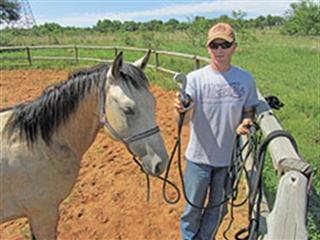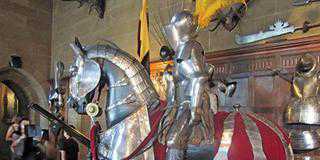
Shane Borland represented South Africa in reining at the World Equestrian Games in 2010 and is well known in the UK for sorting out problem horses. During a recent visit to South Africa he demonstrated a new gadget that prevents horses from ‘pulling back’ in a panic. Horses draw back because they are ‘prey animals’. When they feel pressure on their heads and faces, they’ll instinctively pull away, and panic and struggle as if they’re being attacked by a predator.
Unfortunately, this can have disastrous consequences. They can slip sideways and go down, or shake their heads so vigorously that they break their necks. As a handler, you’re in danger when leading or holding a horse if it suddenly panics and pulls you off your feet, or rears up and falls over backwards. Shane suggests that, by the time they’re 18 months old, colts should have been taught not to pull back against the pressure of a halter. Training should always be in steps, introducing concepts gradually and building on what’s been achieved.
Braided
He leaves a 3m to 4m braided nylon rope, the kind used by mountain climbers (not a ‘ski-rope’), attached to the halter by a bowline knot, and lets the colt walk around the round-pen trailing the rope. The colt learns to yield to the rope when it treads on it and the rope pulls against the halter. For those of us who’ve been taught at pony club to never leave a rope trailing from the halter as it could get tangled in the horse’s legs, this seems like heresy.
So it’s amazing to see how quickly the colt teaches itself to lift its foot to relieve the pressure after treading on the rope. The next step is to encourage the colt to move a little faster with the rope dangling around its feet. Within a few sessions, the colt is able to be round-penned in the arena, even changing direction at a canter, tangling its feet and then pausing to untangle them, or shake off the rope. Part of the secret to success is that the braided polypropylene climbing rope is very flexible and doesn’t easily pull tight, which would happen with a plaited ski-rope or flat cotton lunging rein.
Pressure
Once the colt understands this step, the next stage is to use a gadget to prevent it pulling back against pressure when being led or tied. Shane acknowledges that his method is loosely based on the teachings of Pat Pirelli. He uses the Pirelli rope halter on the colt, as it has strategically placed knots that put pressure on its face. A strong metal ring is securely tied to a wooden cross-pole in the round-pen with a nylon rope. Then a 6m-long propylene lead rope is attached to the halter and threaded through the gadget about 50cm below the colt’s chin.

Shane Borland demonstrates how to startle the horse so that it pulls back.
A screw is tightened slightly so that the rope slides through with just a little resistance. The gadget is snapped into the ring and Shane waits. Usually the colt pulls back and the rope slides slowly through the gadget. As it’s done when stepping on a rope in the earlier lessons, the colt yields to pressure and doesn’t panic. Once this is learnt, Shane deliberately startles the colt by waving his arms and making strange noises until it runs back, but the rope is long enough to maintain pressure without the colt breaking free.
He repeats this several times, and the colt eventually learns not to pull back and will just flinch instead. If this exercise is repeated regularly while the colt is being trained it will eventually lose all fear of being trapped when tied or led. The gadget is also useful for tying horses up while they’re being saddled, washed or loaded in a horse box, and snapping it onto the ring means you don’t have to remember how to tie a quick-release knot.
Contact Dr Mac at [email protected]. Please state ‘Horse talk’ in the subject line of your email.












